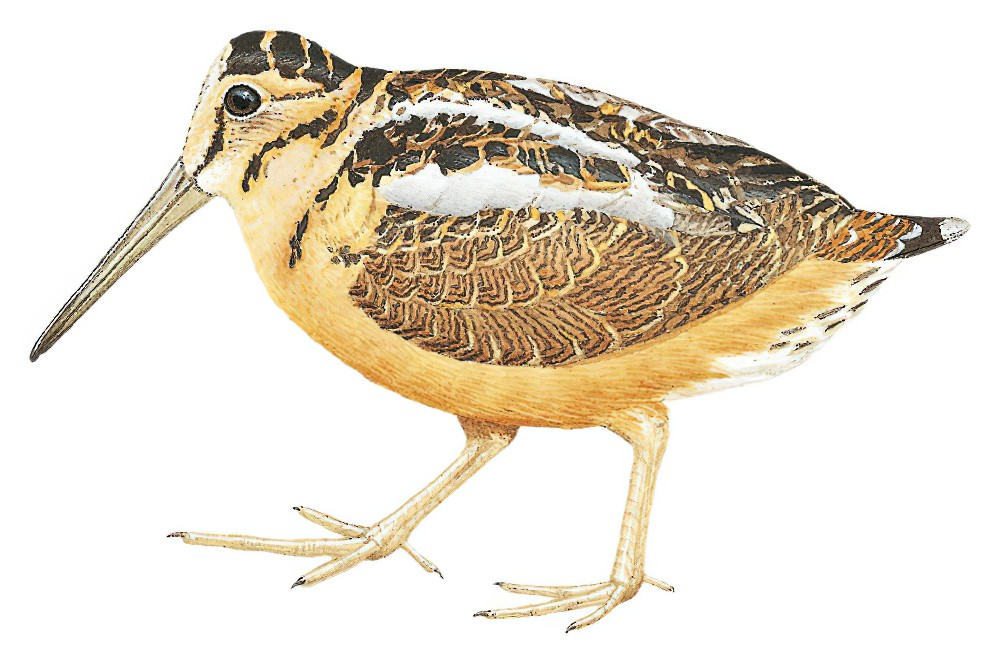American Woodcock / Scolopax minor

American Woodcock
SCI Name:
Protonym: Scolopax minor Syst.Nat. 1 pt2 p.661
Taxonomy: Charadriiformes / Scolopacidae / Scolopax
Taxonomy Code: amewoo
Type Locality: New York, ex Pennant.
Author: Gmelin, JF
Publish Year: 1789
IUCN Status: Least Concern
DEFINITIONS
SCOLOPAX
(Scolopacidae; Ϯ Eurasian Woodcock S. rusticola) L. scolopax, scolopacis snipe, woodcock < Gr. σκολοπαξ skolopax, σκολοπακος skolopakos woodcock < ασκαλωπας askalōpas or ασκαλοπας askalopas woodcock; "77. SCOLOPAX. Rostrum teretiusculum, obtusum, capite longius. Pedes tetradactyli: postico pluribus articulis insistente. ... Species Scolopacum, Tringarum &c. difficillime distinguuntur, ætate sexuque mutabiles, colore parum distinctæ; quæ pedibus sunt rubris a reliquis probe observandæ, cum pedes non varient. ... Scolopaces digitis quatuor insistunt, per paludes vadant. Tringæ per campos littoraque currunt vix digito postico insistentes, uti rite Cel. Kleynius notavit." (Linnaeus 1758); "Scolopax Linné, Syst. Nat., ed. 10, 1, 1758, p. 145. Type, by tautonymy, Scolopax rusticola Linné (Scolopax, prebinomial specific name in synonymy)." (Peters 1934, II, 278). Linnaeus's Scolopax comprised fourteen species (S. rubra, S. alba, S. fusca, S. Totanus, S. Arquata, S. Phæopus, S. Rusticola, S. Fedoa, S. Glottis, S. Limosa, S. Gallinago, S. lapponica, S. Ægocephala, S. Hæmatica). Until the early 1800s Scolopax was used in a very broad sense, and included various snipe, sandpipers, godwits and curlew.
Var. Scopolax, Soclopax, Siolopax.
Synon. Microptera, Neoscolopax, Parascolopax, Philohela, Rubicola, Rusticola.
scolopax
L. scolopax, scolopacis woodcock, snipe (e.g. barred, striped) < Gr. σκολοπαξ skolopax, σκολοπακος skolopakos woodcock < ασκαλωπας askalōpas or ασκαλοπας askalopas woodcock (syn. Burhinus oedicnemus).
minor
L. minor smaller < comp. parvus small. “Comparative names ... Specific names expressive of comparative size are also to be avoided, as they may be rendered inaccurate by the after-discovery of additional species. The names ... maximus, minor, minimus, etc. are examples of this objectionable practice” (Strickland Code 1842).
● ex “Short-eared Owl” of Pennant 1761 (syn. Asio flammeus).
● ex “Little Thrush” of Catesby 1731-1743, Edwards 1758-1764, Latham 1783, and Pennant 1785, “Turdus iliacus carolinensis” of Brisson 1760, and “Grivette de l’Amérique” of de Buffon 1770-1783 (syn. Catharus fuscescens).
● ex “Whip-poor-will” of Catesby 1731 (Chordeiles).
● ex “Coucou des palétuviers de Cayenne” of d’Aubenton 1765-1781, pl. 813, “Petit Vieillard” of de Buffon 1770-1783, and “Mangrove Cuckow” of Latham 1782 (Coccyzus).
● "54. PICUS. ... minor. 12. P. albo nigroque varius vertice rubro, ano albido. Picus albo nigroque varius, rectricibus tribus lateralibus seminigris. Fn. svec. 83. Hasselqv. iter. 242. Picus varius tertius. Raj. av. 43. Picus varius minor. Alb. av. I. p. 20. t. 20. Habitat in Europa.” (Linnaeus 1758) (Dryobates).
● ex “Fregata minor” of Brisson 1760, “Petite Frégate” of de Buffon 1770-1783, “Man of War Bird” of Edwards 1760, and “Lesser Frigate Pelican” of Latham 1785 (Fregata).
● ex “Petit Indicateur” of Levaillant 1807, pl. 242 (Indicator).
● ex “Pie-grièsche d’Italie” of d’Aubenton 1765-1781, pl. 32, fig. 1 (Lanius).
● ex “Perruche à ailes noires” of de Buffon 1770-1783, “Petite perruche de l’isle de Luçon, 4ème ésp.” of Sonnerat 1776, and “Luzonian Parrakeet” of Latham 1781 (syn. Loriculus philippensis).
● ex “Apiaster Philippensis minor” of Brisson 1760 (syn. Merops viridis americanus).
● ex “Little Woodcock” of Pennant 1785, and Latham 1785 (Microptera).
● ex “Troupiale de la Caroline” of d’Aubenton 1765-1781, pl. 606, fig. 1, “Petit Troupiale noir” of de Buffon 1770-1783, and “Lesser black Oriole” of Latham 1782 (syn. Molothrus ater).
● ex “Lesser Bird of Paradise” of Latham 1783 (Paradisaea).
● ex “Barbican à ventre rose” of Levaillant 1806 (Pogonornis).
● ex “Porphyrio minor” of Brisson 1760 (syn. Porphyrula martinica).
● ex “Colymbus fluviatilis” of Brisson 1760 (syn. Tachybaptus ruficollis).
● ex “Huppe d’Afrique” of Audebert & Vieillot 1800-1802 (syn. Upupa africana).
● ex “Ringvia” of Brünnich 1764, and “Lesser Guillemot” of Pennant 1785 (syn. Uria aalge).
MINO
(Sturnidae; Ϯ Yellow-faced Myna M. dumontii) Hindi name Maina for starlings and mynahs; “Greater Minor” or “Mino” were names given to the Common Hill Mynah Gracula religiosa by Edwards 1743; "Sous-genre MINO, Mino, N. ... Le sous-genre que MM. L. et G. établissent en conservant l'ancien nom indien de Mino ou de Minor, donné par Edwards et par Marsden au Mainate, diffère du genre Mainatus par quelques caractères assez distincts. Il semble former le passage des genres Mainatus et Pastor par l'intermédiaire du Philedon goulin (Pastor musicus, Temm., ou Gracula calva), qui devra s'y rapporter très-probablement. ... Une seule espèce appartient encore à ce sous-genre: c'est le Mino de Dumont (Mino Dumontii, Less.) de la Nouvelle-Guinée." (Lesson 1827); "Mino Lesson, 1827, Bull. Sci. Nat. Geol, (Bull. Univer. Sci. Indus., sec. 2), 10, p. 158. Type, by monotypy, Mino dumontii Lesson." (Amadon in Peters 1962, XV, 115).
Var. Mina, Minor.
Synon. Eumathes, Melanopyrrhus.
UPPERCASE: current genus
Uppercase first letter: generic synonym
● and ● See: generic homonyms
lowercase: species and subspecies
●: early names, variants, mispellings
‡: extinct
†: type species
Gr.: ancient Greek
L.: Latin
<: derived from
syn: synonym of
/: separates historical and modern geographic names
ex: based on
TL: type locality
OD: original diagnosis (genus) or original description (species)












